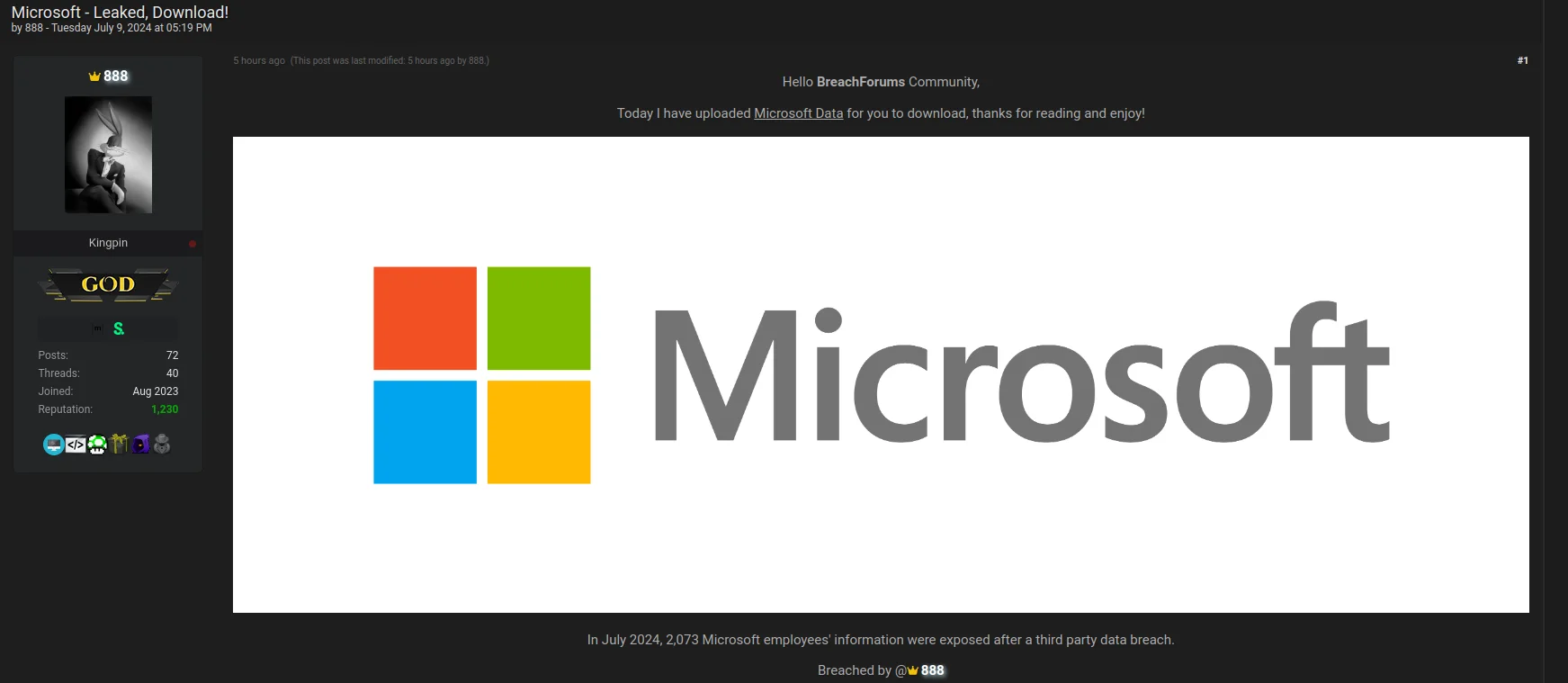Office365 Data Breach Leads To Multi-Million Dollar Theft

Table of Contents
The Vulnerability of Office365
Office365, while offering numerous benefits, presents several vulnerabilities that cybercriminals exploit. Understanding these weaknesses is crucial for implementing effective preventative measures.
Phishing and Social Engineering Attacks
Phishing emails remain a primary vector for Office365 data breaches. These deceptive emails often mimic legitimate communications, tricking employees into revealing sensitive information or clicking malicious links.
- Examples: Emails appearing to be from internal colleagues, system administrators, or even Microsoft itself, requesting login credentials or containing links to fake login pages.
- Successful Attack Vectors: Exploiting employees' lack of security awareness, using spear-phishing targeting specific individuals with personalized information, leveraging current events or company news to increase credibility.
- Employee Training Failures: Inadequate security awareness training leaves employees vulnerable to sophisticated phishing techniques. Statistics show that a significant percentage of successful breaches are attributed to employees falling victim to phishing scams. For instance, a recent study by Verizon found that phishing remains the leading cause of data breaches.
Weak Passwords and Password Reuse
Weak or reused passwords significantly increase the risk of an Office365 data breach. Cybercriminals often use readily available password lists or brute-force attacks to gain access to accounts with easily guessable passwords.
- Best Practices for Password Management: Implementing strong, unique passwords for each account, using password managers to generate and store complex passwords securely, regularly updating passwords.
- Multi-Factor Authentication (MFA) Importance: MFA adds an extra layer of security, requiring users to verify their identity through a second factor, such as a code from a mobile app or a security token. This significantly reduces the risk of unauthorized access even if a password is compromised. Statistics show that MFA reduces the risk of successful breaches by over 99%.
Lack of Multi-Factor Authentication (MFA)
The absence of MFA is a critical security oversight. Even with strong passwords, a single compromised credential can grant attackers complete access to an Office365 account.
- Different Types of MFA: One-time passwords (OTPs), biometrics (fingerprint or facial recognition), security keys.
- Benefits of Implementing MFA: Increased security, reduced risk of unauthorized access, improved compliance with industry regulations.
- Cost-Benefit Analysis of MFA: While implementing MFA may involve some initial costs, the cost savings from preventing a major data breach far outweigh the investment. Many case studies demonstrate the effectiveness of MFA in preventing successful attacks.
The Case Study: A Multi-Million Dollar Office365 Data Breach
A recent case involved a manufacturing company that experienced a significant Office365 data breach, resulting in a multi-million dollar loss.
How the Breach Occurred
The breach began with a targeted phishing email sent to a high-level financial executive. The email appeared to be from the company's CEO, requesting urgent wire transfer instructions. The employee, unaware of the phishing attempt, complied with the request, leading to the transfer of significant funds to an offshore account.
- Chronological Timeline of the Attack: The attackers meticulously tracked the financial executive's daily activities, crafting a highly targeted phishing email to maximize its chances of success. The funds were transferred within hours.
- Specific Vulnerabilities Exploited: The absence of MFA and lack of employee training on recognizing phishing attempts were critical factors contributing to the success of the attack.
- Steps Taken by the Attackers: The attackers used sophisticated techniques to mask their tracks, including using anonymizing services and routing the stolen funds through multiple accounts.
The Financial Impact
The financial impact was devastating. The company lost several million dollars in stolen funds, incurred substantial legal fees, and experienced significant reputational damage.
- Direct Financial Losses: Millions of dollars in stolen funds, loss of revenue due to operational disruption.
- Indirect Costs: Legal fees associated with investigations and potential lawsuits, public relations costs to mitigate reputational damage, the cost of remediation and enhanced security measures.
Lessons Learned
The incident highlighted several critical security oversights.
- Weaknesses in Security Protocols: The lack of MFA was a major vulnerability.
- Insufficient Employee Training: The employee lacked the awareness to identify and report the phishing attempt.
- Lack of Incident Response Planning: The company lacked a well-defined incident response plan to handle the situation effectively.
Protecting Your Business from Office365 Data Breaches
Preventing an Office365 data breach requires a proactive and multi-layered approach.
Implementing Robust Security Measures
Businesses must implement stringent security measures to protect their Office365 data.
- Regular Security Audits: Conduct regular security assessments to identify and address potential vulnerabilities.
- Strong Password Policies: Enforce the use of strong, unique passwords and regularly update password policies.
- Employee Security Awareness Training: Provide comprehensive security awareness training to educate employees about phishing scams, social engineering tactics, and best security practices.
- MFA Implementation: Mandate MFA for all Office365 accounts.
- Data Encryption: Encrypt sensitive data both in transit and at rest.
- Access Control Lists: Implement strict access control lists to limit user access to only necessary data and applications.
Utilizing Office365's Built-in Security Features
Microsoft provides numerous built-in security tools within Office365.
- Advanced Threat Protection (ATP): Helps detect and block malicious emails and attachments.
- Data Loss Prevention (DLP): Prevents sensitive data from leaving the organization's network.
- Information Protection Tools: Enables granular control over access to sensitive information.
- Audit Logs: Monitor user activity and identify potential security breaches.
The Importance of a Comprehensive Cybersecurity Strategy
A holistic approach to cybersecurity is crucial, extending beyond Office365.
- Regular Backups: Regularly back up important data to prevent data loss in case of a breach.
- Disaster Recovery Planning: Develop a comprehensive disaster recovery plan to ensure business continuity in the event of a major incident.
- Incident Response Plan: Establish a clear incident response plan to handle security incidents effectively.
- Third-Party Risk Assessment: Regularly assess the security risks associated with third-party vendors and partners.
Conclusion
Office365 data breaches pose a significant financial risk to businesses. The case study demonstrates the devastating consequences of inadequate security measures, resulting in multi-million dollar losses. Implementing robust security measures, including MFA, comprehensive employee training, and a holistic cybersecurity strategy, is crucial to protecting your organization. Don't wait until it's too late. Take immediate action to improve your Office365 security posture by implementing MFA and conducting a thorough security audit. Protecting your business from an Office365 data breach is an investment that will safeguard your financial stability and reputation. Learn more about securing your Office365 environment and preventing costly data breaches today!

Featured Posts
-
 Ukraine War Russia Resumes Offensive After Easter Ceasefire
Apr 22, 2025
Ukraine War Russia Resumes Offensive After Easter Ceasefire
Apr 22, 2025 -
 Ohio Train Derailment Toxic Chemical Lingering In Buildings
Apr 22, 2025
Ohio Train Derailment Toxic Chemical Lingering In Buildings
Apr 22, 2025 -
 Are Bmw And Porsche Losing Ground In China A Competitive Landscape Analysis
Apr 22, 2025
Are Bmw And Porsche Losing Ground In China A Competitive Landscape Analysis
Apr 22, 2025 -
 The Growing Trend Of Betting On The Los Angeles Wildfires
Apr 22, 2025
The Growing Trend Of Betting On The Los Angeles Wildfires
Apr 22, 2025 -
 Stock Market Valuations Bof A Explains Why Investors Shouldnt Worry
Apr 22, 2025
Stock Market Valuations Bof A Explains Why Investors Shouldnt Worry
Apr 22, 2025
